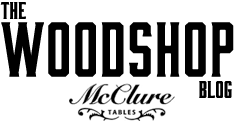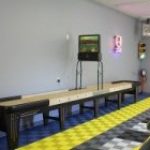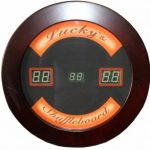
McClure Shuffleboards New Traditional Shuffleboard Playing Surface Finish
We have been in the game room industry for over 35 years. Most of that past was in the sales and service of billiard tables, game tables, and shuffleboard tables. I started as a billiard mechanic (someone who installs and repairs pool tables) when I was 19. During our history, we have had retail stores in Arizona and Texas, but for the last seven years, we have focused exclusively on the manufacture and sales of shuffleboard tables available on our website. Throughout history, we have heard the pros and cons of the polymer epoxy-bar top-poured shuffleboard finish. At one time in Texas, when we ran our retail store, we sold some game room furniture to a customer and was asked if we could move his shuffleboard from his old house to his new game room. He had about a 40 to 50-year-old American Shuffleboard®, and it was probably in a commercial location before he placed it in his home.
He asked if we could get the top refinished, and we said, “Sure.” At the time, we called up Champion Shuffleboard® since they were in Texas and they gave us a price to have the board refinished with a new polymer top. They did a nice job on the top, but once installed, it took less than one hour before the customer called us and asked to remove it and return his old finish. He did not like the epoxy. It was not what he was used to. We called Champion Shuffleboard®, but they did not do a traditional finish. They did refer us to a person who ran a repair route in Oklahoma that would go around to commercial locations and refinish boards or switch them out with a traditionally finished board. He was very happy once we got him a new top with a traditional finish. We would like to point out some things we know about the difference from other finishes and why the polymer tops are offered and prevail. The main reason was for commercial use. The lacquers and shellacs used 50 to 60 years ago simply couldn’t withstand heavy use. The top surface would wear off after a few years, and the board surface would need a new finish.
However, in the past, they used all hard maple to make the board tops, so they were resistant to the dings and dents when people dropped pucks on the board so the wood remained in good shape, and only the chemical coating needed replacement. I have seen boards in a commercial location for maybe up to 10 years and then in a customer’s home for 50 years still with the original finish or, at best, one extra coat of shellac put on top at once. These boards have a few dents and dings, but if we get one 60 years old in this good shape, we simply scuff sand it and apply a new finish. There is no need to sand down the top in a planner/sander machine and put on a completely new finish. How can we tell if the board has ever been running through a sander and/or planner and resurfaced? It is simple; the original old boards were all hard rock maple and a full 3′ thick. Less than indicates work has been done. The main reason was that the board would be resurfaced a few times over its history and that 3’ thickness would allow for a new surface sanding through a machine periodically. I have seen old boards only 2.5 inches thick, so they may have been a few times throughout their history.
Today, many boards are made out of soft maple, and because they pour an epoxy top over the wood, any impact on dents and dings will not impact the soft maple’s softer nature. However, this epoxy is basically like a sheet of Plexiglas. The main reason manufacturers use soft maple is that it is less expensive and easier on the machine tools for cutting and planning. Also, if they use a radio frequency press to glue up the boards, they can get by with a lower-wattage generator since soft maple is easier to glue and laminate. Another feature of the polymer top boards is that they do not have to fill in or sand the top before pouring the polymer with as much care because slight imperfections will be covered with the plastic. The polymer is a poured epoxy in a liquid form, and it will self-level and fill in any slight variations in the top. They will also surface the board down to 2 and ¾ inches thick before they pour the polymer, so they can often start with only 3′ wide boards when they manufacture the board. With the traditional type finish, we use hard maple wood just like they did 60 years ago, so it is resistant to dents and dings.
We also have to start with three ¼ inches thick wood, as after we surface before the finish, it will net out at a full 3 inches thick. We also have to take much more care to fill in and ensure the top is perfectly flat and surfaced both top and bottom with no imperfections before the finishing work. With today’s new finish materials, you have surfaces that you can lay down 3 to 4 mils thick that are virtually all solids. We worked with our finish supplier to develop a formula that we were confident enough to give a lifetime warranty but still retain the natural feel and beauty of the maple wood. McClure Tables makes many traditional-style shuffleboard tables better suited for the traditional finish.
Many are replicas of shuffleboards made in the late 40s and 50s, so we decided to switch to a traditional finish on all our shuffleboard playing surfaces. Not only can you see the difference, but you can also hear the difference. See our latest shuffleboard YouTube video here or see below the features of our new finish:




I’m a newbie to shuffleboard. I was told tables are slightly concave to allow pucks to curve around stationary pucks. True or not?
Yes you do want it concave to keep pucks from falling off the table the slightly often becomes excessive for the game of knock off. You are talking about where people want to wrap shuffleboard weights or they want to play the game knock off. With older games like Horse Collar you want a flat board that is more difficult to maintain with the polymer style coating as it pulls on the boards making it more required to keep a concave verses flat board. With the traditional finish you choose how you want your board to play you are not restricted to only have slightly concave board as polymer style boards require.
When you say traditional surface. What is the finish you apply?
We have a very technical process it is material that a consumer can not purchase, It comes from Italy and is very volatile and dangerous to work with. We have a special machine that has to mix the two parts at the gun it is not like a conversion varnish or catalyzed polyurethane. The base material has a pot life of about 20 to 30 seconds if you mixed the two parts together. We have not fully sent off for testing or taken the time to change our written warranty but we will guarantee this finish for 5 years in a commercial location.
It is not something you can do on your own in a home, you also would not get the same results without the precision sanding equipment. You can read about some of the precision sanding equipment we use here. We do have a video on line in our buying guide series, but it is something we share when people are considering purchase a new table. We are not trying to keep anything secrete ask any finish person if they are familiar with the type material a Gibson Guitar or Steinway Piano manufacture would use. If you have someone in your area with the equipment you could apply our finish. We do not tell everyone about it as we do not want people disappointed if they have one of our older boards or the polymer type boards. We are the only Shuffleboard manufacture in the world that we know of that puts this much time and care into their play-boards.
My table is 18×104 and is crowned in middle. Pucks slidevodd the sides. Does not have climate adjusters. Can this be repaired ? Do you sell just the playing surface?? Bill in Ankeny
You can try adding some climate adjusters we do sell the top only
I recently purchased 6 small climactic adjusters from you. We are making a home table. Will these work with an epoxy finish? Or is a polyurethane recommended. Our surface is a 1.5 inch thick burch butcher block. Thanks for any advice!
Yes this will work with any finish, Thank you for the business